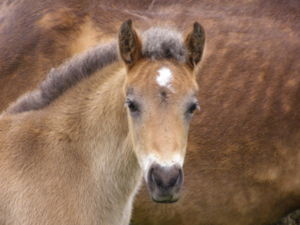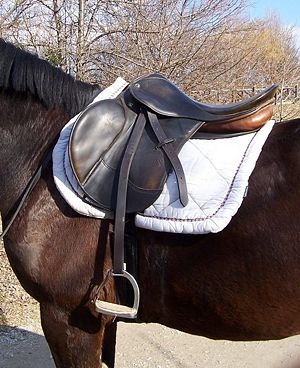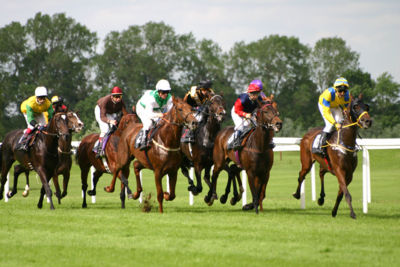Horse/Choosing a horse: Difference between revisions
imported>Nancy Sculerati MD |
imported>Nancy Sculerati MD m (→External Links) |
||
| Line 88: | Line 88: | ||
] | ] | ||
[[Category:CZ Live]] | [[Category:CZ Live]] | ||
[[Category:Biology]] | [[Category:Biology Workgroup]] | ||
[[Category:Hobbies]] | [[Category:Hobbies Workgroup]] | ||
Revision as of 20:29, 10 February 2007
Choosing a horse means making a large commitment, larger than is involved in obtaining any other common domestic animal. Horses are long lived, "high-maintenance" creatures that are almost always much easier to buy than to sell. Any new horse owner is best off tackling the task of finding that first horse with the help of real professionals, including the teachers and trainers that know her riding skills and personality. But, like with every other important decision, the final choice is up to the individual making it. Armed with knowledge, the novice horse-buyer is in a better position to navigate the process of finding, buying, and settling in the right horse. This article reviews some of the basic advice that has been published by equestrians on those topics.
Horse or pony?
Age
Breed
Which breed of horse or pony?
Gelding, Mare, or Stallion?
Unlike dogs and cats, the female horse is rarely de-sexed (neutered) surgically. This is very major surgery in equines. Rarely, such surgery might be recommended for behavioral or health problems, but it is never routine.
Colts, on the other hand, are commonly castrated in their early years and, after this neutering, are called geldings. Stallions are the relatively few adult male horses that have been "left entire". There are certain breeds of horses, such as Lippanzers, in which the colts are regularly allowed to become stallions, but in many other breeds this is discouraged because the full-grown stallion is so difficult to control, especially around either a mare in heat (estrus) or another stallion.
The hormones produced by the stallion's testes
Discipline: what do you want from the horse?
Western or English?
Although Western style riding includes classes in English pleasure, horses trained for that discipline may not be as comfortable with being ridden "on the bit".
Competition
Trail (Hack)
Companion horse
Horses are herd animals and it is a very rare horse who is happy living alone. Although some owners provide their horse with an animal of another species, like a goat, to provide needed company, there are many "companion horses" for sale (or for free) that can make the paddocks a happier place for a single horse. In 'horsepeople terms", a companion horse is generally not one that can or should be ridden or used for any purpose except companionship for another horse.
Available facilities: what can you offer the horse?
"Horse traders"- Caveat emptor!
Where can a horse be obtained?
Breed Organizations
Trainers
Public sales
Auctions
Rescue horses
In the UK, the RSPCA offers horse adoption [1]
Racehorses
Thoroughbred race horses [2]. Other organizations place a variety of race horses, including standard bred pacers [3]
How can a horse be properly evaluated?
Avoiding injury
The reality of equestrian activities is that death and serious injury, including permanent paralysis, are not rare events. Such outcomes cannot be entirely prevented by proper training of horse and rider, the correct use of sound equipment in adequate facilities, or by riding only under proper supervision - but they can be readily prompted by any or all of the opposite practices. Horse shopping can be a very dangerous pastime for that reason.
Horses are so expensive to transport that a horse is usually first evaluated at its home facility. Despite what is advertised by the seller, this may be a field or paddock that has poor footing for riding and may even be shared by other horses. This is not a safe place for any amateur to ride a new horse for the first time.
Tack may be supplied by the seller for a trial ride, and that arrangement often has the advantage of a bit and bridle that the horse is accustomed to, rather than a novel arrangement. It is not impolite to double check all aspects of the tack rather than take the word of the seller that "everything is fine". The potential buyer is wise to watch the horse being brought in and being tacked up.
The equestrian who is interested in avoiding catastrophe is generally advised to never ride a horse, no matter how safe and well-trained the animal is said to be, without seeing the horse ridden immediately beforehand by a person who is familiar with it.
Health evaluation
Vet Check
Equine vets routinely perform what is known as a "pre-purchase exam". Certain features of this examination, done for pleasure or sport performance horses, are common to most countries and disciplines worldwide[4]. The cost of the examination is generally borne by the potential buyer. One good reason for this is to avoid a conflict of interest on the part of the vet. Not only is the buyer better off paying for the examination, the buyer is also wise to choose the vet rather than use a vet supplied by the seller's recommendation.
A rider will be required to be present at the time of the vet's examination because the horse will be put through its paces under tack. The buyer, or her agent, is best present at the time of this exam.
X-rays
Laboratory tests
Breed specific tests
Further Reading
The Complete Trail Horse: Selecting, Training, and Enjoying Your Horse in the Backcountry ISBN 1-59228-251-2
Buying and Selling a Horse: Storey Country Wisdom Bulletin A-122 ISBN 0-88266-654-1
External Links
A New Zealand Pony Club article on "Choosing a horse (pony)" [5]
American Veterinary Medical Association's Guide to "Buying a horse". [http://www.avma.org/communications/brochures/buying_horse/buying_horse_brochure.asp ]


